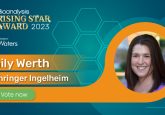Bioanalysis Rising Star Award finalist: Xiaoyu Wang
Nominated by: Hui Wei, Professor in the Department of Biomedical Engineering at Nanjing University (Jiangsu, China)
Supporting comments:
“Xiaoyu was a postdoctoral researcher in my research group at Nanjing University before he moved to Nanjing Forestry University. In the past several years, his research work greatly promoted the development of nanozyme bioanalysis. Xiaoyu developed a straightforward and predictive activity descriptor for guiding the search for highly active nanozymes, which provided the basic research for nanozyme bioanalysis. This interesting work was published by Nature Communications. Besides these projects, he developed nanozyme sensors and sensor arrays for versatile analytes from bioactive small molecules to proteins and even cells. Some of these results have been published in Analytical Chemistry. He has also established himself as a leader of nanozyme-enabled bioanalysis in my research group.
Inspired by his work, several research programs have been performed, and the results were published in Nano Letters, Analytical Chemistry, etc. Xiaoyu won numerous prestigious awards due to his contribution to the bioanalytical community. For example, he obtained the ‘2022 Edward Steers Bursary Award’, which was awarded by The Association of British Spectroscopists Trust. Overall, Xiaoyu is a creative and collaborative young researcher and I am confident in his potential for future success. Therefore, I most enthusiastically support his application for this prestigious Bioanalysis Rising Star Award.”
Describe the main highlights of your bioanalytical work
My work focuses on developing innovative bioanalytical methodologies by using highly active nanozymes.
First, by innovatively studying the relationship between the electronic structure of active sites and the peroxidase-like activity of nanozymes, I demonstrated the efficacy of eg occupancy to predict and identify the peroxidase-like activity of perovskite oxide nanomaterials. Then, I used the guiding principles to design and fabricate highly active nanozymes. In addition, I developed a surfactant-assisted method for preparing 2D metal–organic frameworks based on single zinc sites nanozyme (SZN-MOFs). The SZN-MOFs exhibited remarkable peroxidase-like activity due to the abundant accessible single-atom active sites and the small substrate diffusion resistance.
Second, based on these high-performance nanozymes, I developed several innovative biomimetic recognition-based analytical methodologies for biologically important targets (e.g., bioactive molecules, proteins and cells). Inspired by the response of gustatory and olfactory systems to taste and smell, I constructed cross-reactive sensor arrays using as-developed highly active peroxidase-like nanozymes for fingerprint identification of versatile analytes, enabling the multiplex detection capacity of a nanozyme sensor. The nanozyme sensor arrays were also applied for probing the hydrolytic processes involving ATP and PPi. Furthermore, to provide more reliable and robust sensing performance, I developed fluorescent nanozyme sensing systems with ratiometric signal outputs.






